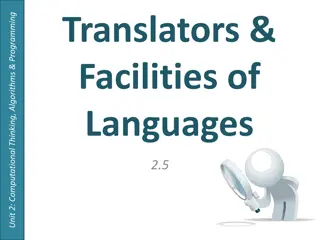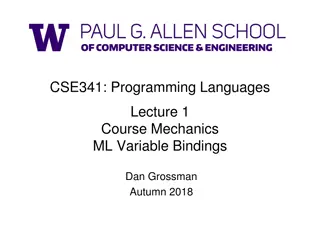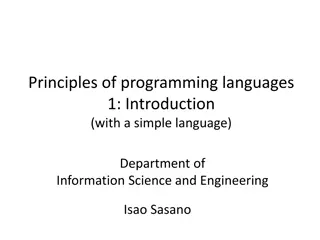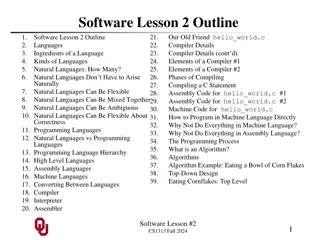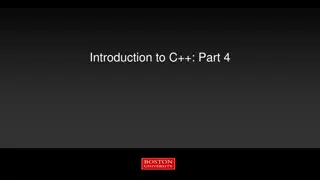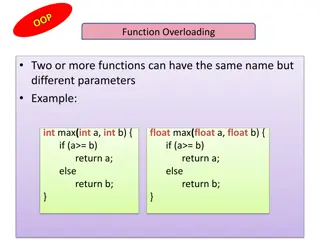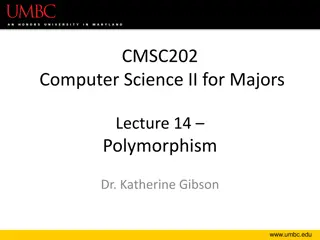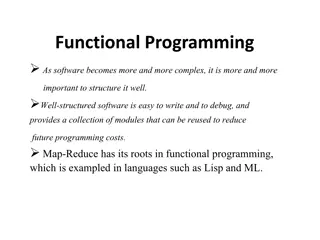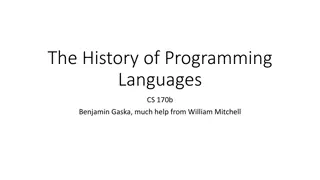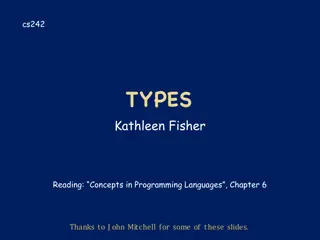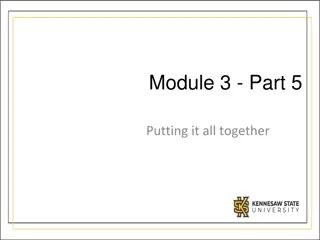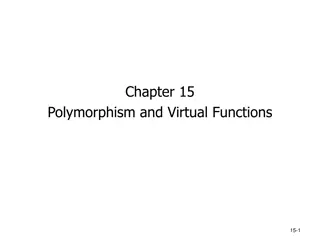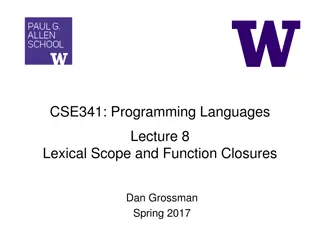Understanding Ad-hoc Polymorphism and Overloading in Programming Languages
Exploring the concepts of ad-hoc polymorphism and overloading in programming languages, this text delves into the differences between parametric and ad-hoc polymorphism, the significance of overloading, and various approaches to implementing overloading for different types of operations.
Download Presentation

Please find below an Image/Link to download the presentation.
The content on the website is provided AS IS for your information and personal use only. It may not be sold, licensed, or shared on other websites without obtaining consent from the author. Download presentation by click this link. If you encounter any issues during the download, it is possible that the publisher has removed the file from their server.
E N D
Presentation Transcript
COMP150PLD TYPE CLASSES Reading: Concepts in Programming Languages , New Chapter 7, Type Classes; How to make ad-hoc polymorphism less ad hoc (both available on web site) Thanks to Simon Peyton Jones for some of these slides.
Polymorphism vs Overloading Parametric polymorphism Single algorithm may be given many types Type variable may be replaced by any type iff::t t then f::Int Int, f::Bool Bool, ... Overloading A single symbol may refer to more than one algorithm. Each algorithm may have different type. Choice of algorithm determined by type context. + has types Int Int Float Float, but not t Int and Float t t for arbitrary t.
Why Overloading? Many useful functions are not parametric. Can member work for any type? member :: [w] -> w -> Bool No! Only for types w for that support equality. Can sort work for any type? sort :: [w] -> [w] No! Only for types wthat support ordering.
Why Overloading? Many useful functions are not parametric. Can serialize work for any type? serialize:: w -> String No! Only for types w that support serialization. Can sumOfSquares work for any type? sumOfSquares:: [w] -> w No! Only for types that support numeric operations.
Overloading Arithmetic First Approach Allow functions containing overloaded symbols to define multiple functions: square x = x * x -- legal -- Defines two versions: -- Int -> Int and Float -> Float But consider: squares (x,y,z) = (square x, square y, square z) -- There are 8 possible versions! This approach has not been widely used because of exponential growth in number of versions.
Overloading Arithmetic Second Approach Basic operations such as + and * can be overloaded, but not functions defined in terms of them. 3 * 3 -- legal 3.14 * 3.14 -- legal square x = x * x -- Int -> Int square 3 -- legal square 3.14 -- illegal Standard ML uses this approach. Not satisfactory: Why should the language be able to define overloaded operations, but not the programmer?
Overloading Equality First Approach Equality defined only for types that admit equality: types not containing function or abstract types. 3 * 3 == 9 -- legal a == b -- legal \x->x == \y->y+1 -- illegal Overload equality like arithmetic ops + and * in SML. But then we can t define functions using == : member [] y = False member (x:xs) y = (x==y) || member xs y member [1,2,3] 3 -- ok if default is Int member Haskell k -- illegal Approach adopted in first version of SML.
Overloading Equality Second Approach Make equality fully polymorphic. (==) :: a -> a -> Bool Type of member function: member :: [a] -> a -> Bool Miranda used this approach. Equality applied to a function yields a runtime error. Equality applied to an abstract type compares the underlying representation, which violates abstraction principles.
Overloading Equality Third Approach Only provides overloading for ==. Make equality polymorphic in a limited way: (==) :: a(==) -> a(==) -> Bool where a(==)is a type variable ranging only over types that admit equality. Now we can type the member function: member :: a(==) -> [a(==)] -> Bool member 4 [2,3] :: Bool member c [ a , b , c ] :: Bool member (\y->y *2) [\x->x, \x->x + 2] -- type error Approach used in SML today, where the type a(==)is called an eqtype variable and is written ``a.
Type Classes Type classes solve these problems. They Provide concise types to describe overloaded functions, so no exponential blow-up. Allow users to define functions using overloaded operations, eg, square, squares, and member. Allow users to declare new collections of overloaded functions: equality and arithmetic operators are not privileged. Generalize ML s eqtypes to arbitrary types. Fit within type inference framework.
Intuition Sorting functions often take a comparison operator as an argument: qsort:: (a -> a -> Bool) -> [a] -> [a] qsort cmp [] = [] qsort cmp (x:xs) = qsort cmp (filter (cmp x) xs) ++ [x] ++ qsort cmp (filter (not.cmp x) xs) which allows the function to be parametric. We can use the same idea with other overloaded operations.
Intuition, continued. Consider the overloaded function parabola: parabola x = (x * x) + x We can rewrite the function to take the overloaded operators as arguments: parabola (plus, times) x = plus (times x x) x The extra parameter is a dictionary that provides implementations for the overloaded ops. We have to rewrite our call sites to pass appropriate implementations for plus and times: y = parabola (intPlus,intTimes) 10 z = parabola (floatPlus, floatTimes) 3.14
Type class declarations will generate Dictionary type and accessor functions. Intuition: Better Typing -- Dictionary type data MathDict a = MkMathDict (a->a->a) (a->a->a) -- Accessor functions get_plus :: MathDict a -> (a->a->a) get_plus (MkMathDict p t) = p get_times :: MathDict a -> (a->a->a) get_times (MkMathDict p t) = t -- Dictionary-passing style parabola :: MathDict a -> a -> a parabola dict x = let plus = get_plus dict times = get_times dict in plus (times x x) x
Type class instance declarations generate instances of the Dictionary data type. Intuition: Better Typing -- Dictionary type data MathDict a = MkMathDict (a->a->a) (a->a->a) -- Dictionary construction intDict = MkMathDict intPlus intTimes floatDict = MkMathDict floatPlus floatTimes -- Passing dictionaries y = parabola intDict 10 z = parabola floatDict 3.14 If a function has a qualified type, the compiler will add a dictionary parameter and rewrite the body as necessary.
Type Class Design Overview Type class declarations Define a set of operations & give the set a name. E.g., the operations == and \=, each with type a -> a -> Bool,form the Eq a type class. Type class instance declarations Specify the implementations for a particular type. E.g., for Int, == is defined to be integer equality. Qualified types Concisely express the operations required on otherwise polymorphic type. member:: Eq w => w -> [w] -> Bool
for all types w that support the Eq operations Qualified Types member:: w. Eq w => w -> [w] -> Bool If a function works for every type with particular properties, the type of the function says just that: sort :: Ord a => [a] -> [a] serialise :: Show a => a -> String square :: Num n => n -> n squares ::(Num t, Num t1, Num t2) => (t, t1, t2) -> (t, t1, t2) Otherwise, it must work for any type whatsoever reverse :: [a] -> [a] filter :: (a -> Bool) -> [a] -> [a]
FORGET all you know about OO classes! Works for any type n that supports the Num operations Type Classes square :: Num n => n -> n square x = x*x The class declaration says what the Num operations are class Num a where (+) :: a -> a -> a (*) :: a -> a -> a negate :: a -> a ...etc... An instance declaration for a type T says how the Num operations are implemented on T s instance Num Int where a + b = intPlus a b a * b = intTimes a b negate a = intNeg a ...etc... intPlus :: Int -> Int -> Int intTimes :: Int -> Int -> Int etc, defined as primitives
Many Type Classes Eq: equality Ord: comparison Num: numerical operations Show: convert to string Read: convert from string Testable, Arbitrary: testing. Enum: ops on sequentially ordered types Bounded: upper and lower values of a type Generic programming, reflection, monads, And many more.
Functions with Multiple Dictionaries squares :: (Num a, Num b, Num c) => (a, b, c) -> (a, b, c) squares(x,y,z) = (square x, square y, square z) Note the concise type for the squares function! squares :: (Num a, Num b, Num c) -> (a, b, c) -> (a, b, c) squares (da,db,dc) (x, y, z) = (square da x, square db y, square dc z) Pass appropriate dictionary on to each square function.
Compositionality Overloaded functions can be defined from other overloaded functions: sumSq :: Num n => n -> n -> n sumSq x y = square x + square y sumSq :: Num n -> n -> n -> n sumSq d x y = (+) d (square d x) (square d y) Extract addition operation from d Pass on d to square
Compositionality Build compound instances from simpler ones: class Eq a where (==) :: a -> a -> Bool instance Eq Int where (==) = intEq -- intEq primitive equality instance (Eq a, Eq b) => Eq(a,b) where (u,v) == (x,y) = (u == x) && (v == y) instance Eq a => Eq [a] where (==) [] [] = True (==) (x:xs) (y:ys) = x==y && xs == ys (==) _ _ = False
Subclasses We could treat the Eq and Num type classes separately, listing each if we need operations from each. memsq :: (Eq a, Num a) => a -> [a] -> Bool memsq x xs = member (square x) xs But we would expect any type providing the ops in Num to also provide the ops in Eq. A subclass declaration expresses this relationship: class Eq a => Num a where (+) :: a -> a -> a (*) :: a -> a -> a With that declaration, we can simplify the type: memsq :: Num a => a -> [a] -> Bool memsq x xs = member (square x) xs
Default Methods Type classes can define default methods. -- Minimal complete definition: -- (==) or (/=) class Eq a where (==) :: a -> a -> Bool x == y = not (x /= y) (/=) :: a -> a -> Bool x /= y = not (x == y) Instance declarations can override default by providing a more specific definition.
Deriving For Read, Show, Bounded, Enum, Eq, and Ord type classes, the compiler can generate instance declarations automatically. data Color = Red | Green | Blue deriving (Show, Read, Eq, Ord) Main> show Red Red Main> Red < Green True Main>let c :: Color = read Red Main> c Red
Numeric Literals class Num a where (+) :: a -> a -> a (-) :: a -> a -> a fromInteger :: Integer -> a ... Even literals are overloaded. 1 :: (Num a) => a 1 means fromInteger1 inc :: Num a => a -> a inc x = x + 1 Haskell defines numeric literals in this indirect way so that they can be interpreted as values of any appropriate numeric type. Hence 1 can be an Integer or a Float or a user-defined numeric type.
Example: Complex Numbers We can define a data type of complex numbers and make it an instance of Num. class Num a where (+) :: a -> a -> a fromInteger :: Integer -> a ... data Cpx a = Cpx a a deriving (Eq, Show) instance Num a => Num (Cpx a) where (Cpx r1 i1) + (Cpx r2 i2) = Cpx (r1+r2) (i1+i2) fromInteger n = Cpx (fromInteger n) 0 ...
Example: Complex Numbers And then we can use values of type Cpxin any context requiring a Num: data Cpx a = Cpx a a c1 = 1 :: Cpx Int c2 = 2 :: Cpx Int c3 = c1 + c2 parabola x = (x * x) + x c4 = parabola c3 i1 = parabola 3
Detecting Errors Errors are detected when predicates are known not to hold: Prelude> a + 1 No instance for (Num Char) arising from a use of `+' at <interactive>:1:0-6 Possible fix: add an instance declaration for (Num Char) In the expression: 'a' + 1 In the definition of `it': it = 'a' + 1 Prelude> (\x -> x) No instance for (Show (t -> t)) arising from a use of `print' at <interactive>:1:0-4 Possible fix: add an instance declaration for (Show (t -> t)) In the expression: print it In a stmt of a 'do' expression: print it
Constructor Classes There are many types in Haskell for which it makes sense to have a map function. mapList:: (a -> b) -> [a] -> [b] mapList f [] = [] mapList f (x:xs) = f x : mapList f xs result = mapList (\x->x+1) [1,2,4]
Constructor Classes There are many types in Haskell for which it makes sense to have a map function. Data Tree a = Leaf a | Node(Tree a, Tree a) deriving Show mapTree :: (a -> b) -> Tree a -> Tree b mapTree f (Leaf x) = Leaf (f x) mapTree f (Node(l,r)) = Node (mapTree f l, mapTree f r) t1 = Node(Node(Leaf 3, Leaf 4), Leaf 5) result = mapTree (\x->x+1) t1
Constructor Classes There are many types in Haskell for which it makes sense to have a map function. Data Opt a = Some a | None deriving Show mapOpt :: (a -> b) -> Opt a -> Opt b mapOpt f None = None mapOpt f (Some x) = Some (f x) o1 = Some 10 result = mapOpt (\x->x+1) o1
Constructor Classes All of these map functions share the same structure. mapList :: (a -> b) -> [a] -> [b] mapTree :: (a -> b) -> Tree a -> Tree b mapOpt :: (a -> b) -> Opt a -> Opt b They can all be written as: map:: (a -> b) -> g a -> g b where g is [-] for lists, Tree for trees, and Opt for options. Note that g is a function from types to types. It is a type constructor.
Constructor Classes We can capture this pattern in a constructor class, which is a type class where the predicate ranges over type constructors: class HasMap g where map :: (a -> b) -> g a -> g b
Constructor Classes We can make Lists, Trees, and Opts instances of this class: class HasMap f where map :: (a -> b) -> f a -> f b instance HasMap [] where map f [] = [] map f (x:xs) = f x : map f xs instance HasMap Tree where map f (Leaf x) = Leaf (f x) map f (Node(t1,t2)) = Node(map f t1, map f t2) instance HasMap Opt where map f (Some s) = Some (f s) map f None = None
Constructor Classes Or by reusing the definitions mapList, mapTree, and mapOpt: class HasMap f where map :: (a -> b) -> f a -> f b instance HasMap [] where map = mapList instance HasMap Tree where map = mapTree instance HasMap Opt where map = mapOpt
Constructor Classes We can then use the overloaded symbol map to map over all three kinds of data structures: *Main> map (\x->x+1) [1,2,3] [2,3,4] it :: [Integer] *Main> map (\x->x+1) (Node(Leaf 1, Leaf 2)) Node (Leaf 2,Leaf 3) it :: Tree Integer *Main> map (\x->x+1) (Some 1) Some 2 it :: Opt Integer The HasMap constructor class is part of the standard Prelude for Haskell, in which it is called Functor.
Peyton Jones take on type classes over time Type classes are the most unusual feature of Haskell s type system Hey, what s the big deal? Wild enthusiasm Despair Hack, hack, hack Incomprehension 1987 1989 1993 1997 Implementation begins
Type-class fertility Constructor Classes (1995) Implicit parameters (2000) Extensible records (1996) Computation at the type level Wadler/B lott type classes (1989) Multi- parameter type classes (1991) Functional dependencies (2000) Generic programming Overlapping instances newtype deriving Testing Associated types (2005) Derivable type classes Applications Variations
Conclusions A much more far-reaching idea than the Haskell designers first realised: the automatic, type-driven generation of executable evidence, i.e., dictionaries. Many interesting generalisations: still being explored heavily in research community. Variants have been adopted in Isabel, Clean, Mercury, Hal, Escher, Who knows where they might appear in the future?




